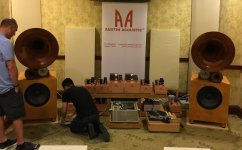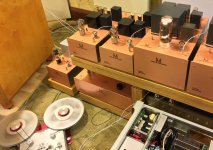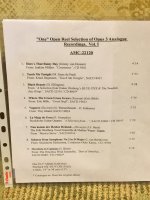That's MIT for you. It is just like the English Prep Schools that would teach someone 'proper' English usage.
Yes, John, that is what happens to us in life too. For instance, there was
and Aggie that went to MIT.
NOTE: An Aggie is someone who went to
and graduated from Texas A&M University, formerly known as the
Agricultural and Mechanical College of Texas.
So, our Aggie is lost on campus and see's an MIT student, walks
up to him and say's Howdy, I'm lost here, can you tell me where
the library's at?
MIT student responds, you know they teach use to speak proper
English here, don't you know that you aren't supposed to end a
sentence with the preposition?
Thinking (which is hard for Aggies to do) he scratches his head,
then responds:
Howdy, I'm lost here, can you tell me where the library is at,
aschloch. Translated here: LINK
Cheers,
Possibly not needless to say,
It doesn’t matter what school someone went to, what matters is the quality of their arguments and reasoning. And in my experience a good school does not guarantee a good graduate.
It’s sort of crass to waive ones academic credentials around in here, isn’t it? Sort of thing people do when they lack confidence.
It doesn’t matter what school someone went to, what matters is the quality of their arguments and reasoning. And in my experience a good school does not guarantee a good graduate.
It’s sort of crass to waive ones academic credentials around in here, isn’t it? Sort of thing people do when they lack confidence.
MIT student responds, you know they teach use to speak proper
English here, don't you know that you aren't supposed to end a
sentence with the preposition?
I doubt you would find the average MIT student correcting grammar. I consider that I escaped from MIT not a single teacher or advisor though I would do anything significant. Millie Dresselhaus, one of the greatest woman scientists of our time, asked me if I needed a passing grade in her course to graduate. I said, well yes, so she said please promise not to be a physicist, OK sure I said. Again these were the exact words.
Last edited:
Joe, you make it very hard not to be rude to you when you seem to promote the idea that one needs no understanding of the underlying physics and math to do audio design. All the things you talk about are easily analysed analytically. If you don't understand complex algebra a lot of things will make no intuitive sense.
You assume too much, or should I say too less?
You look at a structure, don't you ever change from where you are looking at it. Will you stay rooted in one place and criticise those who move around, after they have seen the vantage point you are stuck at? Ever seen the Sydney Opera House? I tell you, there are a thousand angles from which to view it. Exploration is not dead. It is very much alive and it does not at all make what has gone before it invalid, most often, it adds to it. So why does some here think that the foundation is thrown out or threatened - is it insecurity of some sort? I can only wonder?
BTW, do you want his email address?
If you really want to have an intelligent communication, please start with an impedance sweep of a driver and specify the operating and testing conditions...
George
George, I could do that, but I don't think it would be receptive here. But take a look at that impedance graph, draw a lateral line that represents the DC resistance, the X axis, and look at the impedance that is above that line and ask, what causes it? Also, the impedance below the line, being resistive will have a non-complex impedance, but what about above the line? Below not volatile, resistive stable part of the impedance, above not. I think that is likely as far as I will be allowed to go here. Just watch!
Last edited:
I feel your pain, Joe. Even I am having difficulty with what you are trying to describe. Also, I too get criticized by other engineers if I don't use THEIR 'approved' definitions..
In some ways, not that much pain. Kinda liberating too. There are in fact scientists that are looking at this - I saw your earlier comment re loudspeakers as still being a real challenge and decided, OK I will jump in and see what happens. Actually, nothing much that I did not expect - but when somebody pointing out that DC is not a frequency, that was a hoot. So we must not call 0 Hertz a frequency? OK teach! Got it!
Such as DC resistance. We all know what you are talking about, and it has the further info that that is how you have to measure it. Of course inductance or capacitance can be added to it and then we call it 'impedance'. Big deal, but if these guys can take a cheap shot at you, they will. It isn't really worth it to 'teach' them what you are getting at.
Yep, anything that impedes current is an impedance and can be calculated. Let them make all the cheap shots they like - they seem to need it more than I do.
I am not working on this alone, so I am not out on a limb all by myself. But the response here is actually encouraging, if you know what I mean? 😀
Cheers, Joe
You write a few thousand words of incoherence, but when asked for a graph decide we are not worthy of some actual data? I had hoped when you dropped the magenta text that you might have something useful to discuss, but same old same old.George, I could do that, but I don't think it would be receptive here.
It’s sort of crass to waive ones academic credentials around in here, isn’t it? Sort of thing people do when they lack confidence.
The corollary of the opposite in terms of the chip-on-shoulder syndrome, which is such an odd thing between John and Scott, since IIRC John went to Berkeley!
Agree 100% that I hope people take others on their content. The school of hard knocks is a great equalizer, too. One could see making analogies to freshman/sophomore-level coursework as pejorative and waving credentials, but there's an element of, "this isn't something out of reach of anyone who wants to figure it out". Grad level classes, while certainly not insurmountable, do require a healthy bit of legwork to get anything from. Dense material by and large.
Immeasurable differences in circuits making large audible differences? (Ostensibly) 😉
That one in its hundred thousand forms goes over so well.
That one in its hundred thousand forms goes over so well.
You assume too much, or should I say too less?
BTW, do you want his email address?
No thanks, I'll go back to observing.
Richard is right again y'all, on system sound etc. I went to our local audio fest and there was lots of audio at least for my taste wasn't so good.
There was some stuff that was outstanding and priced accordingly. So, Richard was right about when he was discussing the systems that can use the hi-speed play back tape systems.
This system had one and you had to fool with it to get the tape in, then remove the belt to rewind it then feed the the tape, wind it up, put the belt on and play.
This is a solid 1/4 wall of tube gear, mono blocks with each driver has it's own amp, plus each other piece of gear had it's own pre amp too.
The sound was stunning yes.
At $ 4000 a tape not sure seems limited. Didn't have time to audition the vinyl, shame on me. But it was fun.
Also the proper way to store tapes is that run them all the way through in play mode with out stopping.
Then when you are ready to listen again, we fool with it a bit, rewind it, then play. 🙂
Cheers,
There was some stuff that was outstanding and priced accordingly. So, Richard was right about when he was discussing the systems that can use the hi-speed play back tape systems.
This system had one and you had to fool with it to get the tape in, then remove the belt to rewind it then feed the the tape, wind it up, put the belt on and play.
This is a solid 1/4 wall of tube gear, mono blocks with each driver has it's own amp, plus each other piece of gear had it's own pre amp too.
The sound was stunning yes.
At $ 4000 a tape not sure seems limited. Didn't have time to audition the vinyl, shame on me. But it was fun.
Also the proper way to store tapes is that run them all the way through in play mode with out stopping.
Then when you are ready to listen again, we fool with it a bit, rewind it, then play. 🙂
Cheers,
Attachments
Last edited:
It’s sort of crass to waive ones academic credentials around in here, isn’t it? .
I hope you're not talking to me, as I've made it clear I respect actual understanding no more no less. Scientific relativism presented as thinking outside the box comes up all the time, "I made something up that I feel should work, prove me wrong", syndrome.
Richard is right again y'all, on system sound etc.
Not sure Richard is keen on horns and SET amps.
George, I could do that, but I don't think it would be receptive here. But take a look at that impedance graph, draw a lateral line that represents the DC resistance, the X axis, and look at the impedance that is above that line and ask, what causes it? Also, the impedance below the line, being resistive will have a non-complex impedance, but what about above the line? Below not volatile, resistive stable part of the impedance, above not. I think that is likely as far as I will be allowed to go here. Just watch!
Joe,
That impedance line simply represents how hard or easy the amp has to work at each frequency. The high peak represents a resonance. If you look at the phase, note it crosses zero at the magnitude peak. It is simply expressions of how the speaker is reacting to the frequency. Phase lead and lag represent the type of reactance the system provides. Sometimes it looks inductive, and sometimes capacitive.
The only time it presents as pure resistance is when the phase is zero. But as I said, the eddy currents also show zero phase shift.
Any time the load has non zero phase shift, tha amp output transistors have to sink current from the opposite supply voltage (actually absorbing it from the load).the idea of trying to neutralize the impedance swings with passive components is great, but it doesn't alter what the load actually does with the signals. It will only change what the amp sees. If the amp is well designed, it will make no difference.
Jn
So if I'm to translate, either deal with technical things accepted by you, or get bullied by moderation. Do you honestly read the things you post and think that this is fair and okay? My inbox is full of threats. And apparently I've been reported dozens of times and under constant watch. A small number of people are turning this forum into some sort of all think alike cult. It will get real boring real fast around here.Hi John,
Really? Is it worth the creation of confusion to put together a group of "underdogs"? You know much better than this, and if not you're beginning to believe the spin put on things by the flaky hi-end press. We aren't children here, so don't expect anyone to suspend belief in the rules of science that we work with every single day.
So why not, just as an experiment, deal with technical things in an accepted manner. I'll bet you suddenly find that things that caused you some confusion are suddenly crystal clear.
-Chris
Last edited:
I don't know his preference, but the source tapes were damn quiet. Which surprised me as it was "all analogue".Not sure Richard is keen on horns and SET amps.
I couldn't find filtering but that doesn't mean it wasn't there as I didn't hear anything in the background. Those were some quiet and amps. I tried to get a view over the amps, and look behind the screen, but couldn't. Then my kid wanted to come on over and walk between the gear on the floor...I quickly nixed that idea. Had to walk out before she started protesting... too much. So we went to the main lobby where she found another kid and could run around with the other little girl and do no damage.
Most of the tape sources were SACDs or CDs, with one source as LP.
Sadly I didn't have any measuring gear with me, not sure what it would have. I did offer to have them plug in my iPhone and take a USB signal, but the guy said they had no USB input set up.
Cheers,
Post Script, as I went though the Austin Acoustic web site, I went to the information column and read it. What I wonder is whether a difference in passive filtering can occur between the pre amp and the power amp? Or, have we lost so much signal that it doesn't work correctly any longer. I'm thinking the answer is yes. However we have taken the line level output...and broken up the signal.... at that low level...if on just had small line amps feeding the passive sections?
Or do we run into the same problem trying to amplify before an ADC signal were it can also amplify the noise products.
Last edited:
Are the detailed complications necessary at this point? What do you think this means?
The detailed complications are ALWAYS necessary!!! 😕😕
A speaker is never a simple resistor, inductor, and capacitor. All three elements of that construct are frequency and amplitude dependent, and will respond in a non linear way to both frequency and amplitude.
At this point in my life, the simple three element model is a perch to stand on and look at the very complex nature of real components.
It is time to teach the yunguns reality. Not just simulations..
Jn
Ps. I'm now spending my time teaching the motion control software guys reality. They were taught basic software coding and tuning, but they have no clue what closed loop feedback systems do, never heard of bode, assume motors are linear, cannot comprehend involute gearing, the list is so very long.....Luckily, I have a new granddaughter to see, all that hooey is something I won't even look in the rear view mirror as the silver bird takes off...
Pps. The real details, the interested will ask. Those who don't know or care, I will not be concerned with.
Last edited:
A small number of people are turning this forum into some sort of all think a like forum. It will get real boring real fast around here.
The measure of interest is quality of information, not quantity of disagreement. A lot of agreement is a GOOD thing, when the people agreeing have come at their points of view from their own study.
Last edited:
Also, the impedance below the line, being resistive will have a non-complex impedance,
No the impedance is resistive when the phase is zero.
- Status
- Not open for further replies.
- Home
- Member Areas
- The Lounge
- John Curl's Blowtorch preamplifier part III



